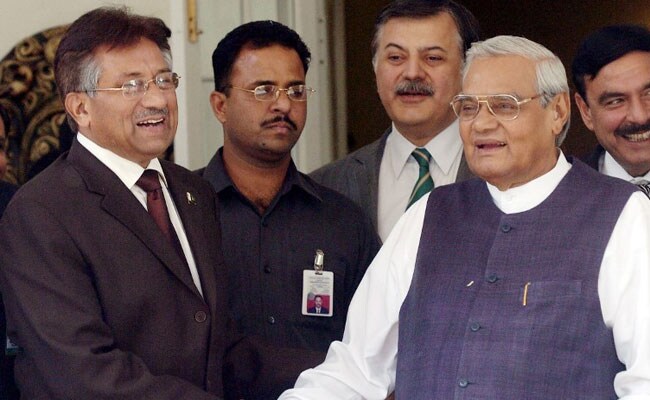Former Foreign Minister of Pakistan Khurshid Mahmud Kasuri revisits the ‘four-point formula’ on the Kashmir issue in the backdrop of the recent ceasefire agreement with India.
The February 25 ceasefire announcement has evoked both optimism and skepticism about the possibility of peace between India and Pakistan. However, the situation between the two countries is not the same as it was during the Vajpayee-Musharraf era when they were at the cusp of ‘resolving’ the Kashmir issue.
Khurshid Mahmud Kasuri, who was Pakistan’s Foreign Minister at the time, observed in his book Neither a Hawk nor a Dove that the “solution to Kashmir was in the grasp of both governments”.
The two governments were working on an agreement called the ‘Four-point solution’ on Kashmir, proposed by then Pakistan President Pervez Musharraf. The solution was reportedly, in principle, acceptable to Prime Minister Atal Bihari Vajpayee, but failed to materialize just hours before the signing ceremony.
Kasuri details the key points of the much talked about ‘Four-point solution’ in an article in Dawn newspaper, describing the situation between the two countries having “improved so dramatically that they had succeeded in even drawing up a framework of a possible agreement on Kashmir”.

The formula drawn up when he was the foreign minister of Pakistan contained 11 or 12 important ingredients, including “substantial demilitarisation beginning with major urban centers with an agreement to keep troops to a minimum along the LoC; this was done, inter alia, also to protect Kashmiris’ human rights”.
The 4-Point Solution
Musharraf’s plan envisaged that the troops of the two countries scale back for lasting peace, and how that was to be implemented would be decided by the two countries mutually.
Secondly, there was a proposal to define “two units of Kashmir”, which would comprise both Pakistan and India-administered Kashmir, “whose governments would be free to have more than one administrative region in the units under their control”.
The third point focused on granting maximum self-governance in the legislative, executive, and judicial areas to both the units. Self-determination for the Kashmiris was something Pakistan had always wanted; however, Musharraf seemed to agree on favoring a greater measure of autonomy under this proposal.
The next clause called for the establishment of a ‘joint mechanism’, consisting of a specified number of elected members from each of the two units, to be nominated by their respective governments. This ‘joint mechanism’ would be created to supervise the issues related to trade and travel between the two administrative units, besides increasing the number of crossing points.
The inclusion of the local Kashmiri leadership in the ‘joint mechanism’ would have given Musharraf a greater chance at convincing his country about the merits of the accord.
Kasuri describes the important responsibilities of this mechanism as “to encourage the promotion of common policies towards the development of infrastructure, hydroelectricity, and exploitation of water resources,” which would go a long way in helping maintain peace between the two countries.
Another important clause in the agreement involved the elimination of militancy through the efforts of both units through DDR (deradicalization, disengagement, and rehabilitation). To ensure lasting peace, it was important to contain and engage separatist or militant groups into accepting the new understanding reached between the two countries.
The next clause focused on the conduct of free and fair elections in the respective units, which would be “made open to international observers and the media”.
The agreement also provided for a monitoring and review mechanism to address any difficulties in the implementation of the proposal. For this purpose, the foreign ministers of Pakistan and India were to meet once a year to review the progress of the agreement.
One significant reform was the unrestricted travel across the LoC, which would just be reduced to “a line on the map”, allowing Kashmiris to travel without visas or passports within the two units. The agreement was sought to be framed on the lines of the Élysée Treaty between Germany and France, which furthered peace, security, and friendship.
“Most importantly, there was an unwritten understanding/agreement that neither side would proclaim victory, once the details of the framework had been announced since it was realized that hardline elements on both sides would find something to disagree with in this framework,” Kasuri writes.
Lastly, the agreement called for the establishment of equal self-governance in both units.
Kasuri recalls that he had sought the opinion of Kashmiris, living in Kashmir and outside, to gauge the general feeling about the agreement. “It would be fair to say that except for Syed Ali Shah Gilani, most others supported it, he adds. In his book, he had written that Geelani described President Musharraf’s four-point agenda as “vague, and criticized the president’s statement on UNSC resolutions’ relevance to Kashmir”.
He added, “Fortunately, other Kashmiri leaders I met recognized the need for unity in the ranks of Kashmiris. They were more pragmatic and, by and large, unwilling to go along with Geelani’s rigid approach.”
Years later, Musharraf blamed the Indian side for backtracking on the agreement even as the draft resolution was ready to be signed. “I was told that the Indian Cabinet had refused to give its nod,” Musharraf told the media persons at an event in 2004.
The current Pakistan PM Imran Khan is said to have supported the ‘four-point formula before he assuming office. However, soon after he took oath as the PM, the relations between the two countries saw the deepest decline with the Balakot strikes and, subsequently, with the abrogation of Article 370 by India on August 5, 2019.
A report by the US Institute of Peace (USIP) had last year claimed that the ‘four-point formula’ proposed by Musharraf continued to be the best available solution to the Kashmir conflict. The formula has been widely accepted also by the Kashmiri leadership as a possible solution to achieving peace in the conflicted region.
Kasuri concludes by saying that it’s important that the talks between the two countries go on through ‘backchannel’ during our time since media coverage is avoided and the speculations remain on the minimum.
Follow EurAsian Times on Google News





